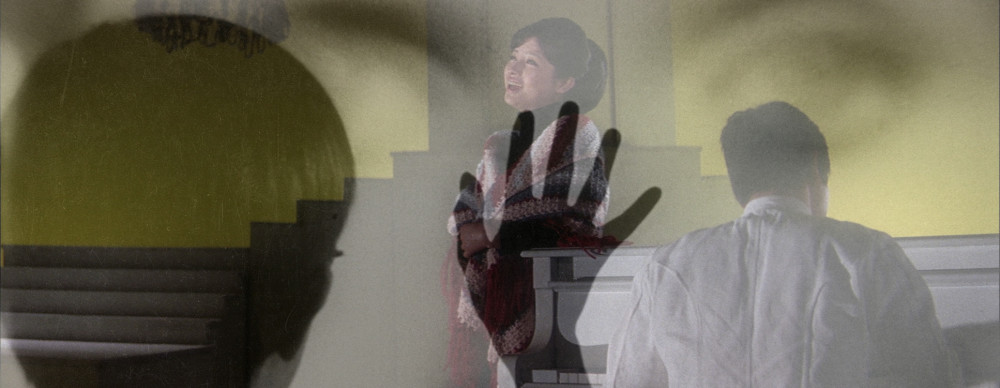
Call me postmodern trash, compare me to a pretentious adolescent invigorated by a first viewing of Fight Club, by all means, but one thing I can’t help but love is a film that calls attention to its own existence as such. Not out of any particular love for the shock factor, mind you—otherwise I’d have to love any cut-rate fourth wall-breaking “mind-bender.” It has more do with the way that such a film, when masterfully executed, reveals the inner workings of the artist’s expertise with the medium. In other words, I like when artists comment on their own art; it allows a peek at their own artistic processes and their attitudes toward their own art, what they believe it can accomplish, what they believe its purpose, if any, might be. Okay, and I also like being just a little mind-blown. What luck for me, then, that both of this round’s films are examples of just that. Seijun Suzuki’s Tokyo Drifter, a yakuza B-movie made famous by the director’s over-the-top stylization, has the effect of generating a critique of its own genre through its conspicuous visual style; Ingmar Bergman’s masterpiece Persona self-destructs before the audience in outright defiance of the conventions which demand that a film reflect a coherent image of an incoherent world.
Tokyo Drifter is a film which, described only in terms of its plot, might seem conventional, perhaps even boilerplate. The elevator pitch: Tetsuya “Tetsu ‘The Phoenix’” Honda (Tetsuya Watari) is a former Yakuza member attempting to re-enter “straight” society after his boss, Kurata (Ryuji Kita), disbands their gang, though Tetsu’s closely-held sense of duty keeps him loyal to Kurata. All too naturally, the world of organized crime comes knocking, and Tetsu and Kurata find themselves in the middle of a real-estate scam organized by Otsuka (Hideaki Esumi), the leader of a rival Yakuza gang. A few incidental homicides later, Kurata tells Tetsu to skip town and keep his head low; thus, Tetsu adopts the life of a drifter.
In the hands of director Seijun Suzuki, however, Tokyo Drifter becomes an extraordinary spectacle. Every visual aspect of the production is vigorously and thoroughly stylized: walls glow red, jade green, and fluorescent violet; the actors are blocked with geometric precision; lights theatrically shut off or change hue at dramatic junctures (i.e. deaths); transitions between scenes are abrupt, if not inscrutable. None of this is “necessary,” in that vague and misguided sense that’s meant to refer to stylism as it is demanded or justified by the plot. It’s instead a celebration of the sensorial excesses made possible by the medium, and all of this is justification enough, for the world would be just a little bit poorer without a film like Tokyo Drifter.
In the same way, Tokyo Drifter, were it directed by any other than Suzuki, would be a poorer film. His experimentation is supremely enjoyable—who, after all, could argue with gunfights set against solid banners of primary colors—and makes for a far more entertaining film than a conventional treatment of the script would produce. However, the sheer pleasure of Tokyo Drifter’s stylization is not like that of, say, hard candy, a one-note treat of ultimately little substance; rather, the sweetness of the film’s style is a key ingredient in a far more satisfying concoction, rich in contradiction and complexity. With Suzuki’s directorial vision so overwhelmingly present, the audience is forced to acknowledge at all times that they are watching a film, a construction. Thus, it becomes impossible to take the film for granted as a self-contained and digestible work.
This awareness affects the film most profoundly in regards to its treatment of genre. Suzuki was a contract director for major Japanese studio Nikkatsu, filming action-oriented B-movies—primarily yakuza films, whose romanticized anti-heroes lived by codes of duty and loyalty not unlike that of the samurai. These films were created in accordance with certain guidelines and strictures; their intent was nothing other than light, profitable entertainment. Suzuki was famously fired after his 1967 magnum opus Branded to Kill, which was accused of being “incomprehensible” and worse, unprofitable. It’s easy to consider Tokyo Drifter a presage of his later dismissal, as the stylistic exuberance of the film (not to mention the madcap slapstick of a barroom brawl in the film’s latter half) stands in tension with the familiar yakuza premise—a tension which elevates, rather than impedes the film.
In drawing attention to the constructed nature of the film, Suzuki’s visual style has the same effect, by extension, on its genre. One is no longer able to take for granted the conventions which constitute the yakuza genre—they are just as much constructions as the compositional elements which Suzuki draws attention to. This premise engenders a satirical view of the genre and the cultural forces which produce it. When Tetsu’s loyalty to his boss results only in his own betrayal, just as a jaded yakuza companion had predicted, it strikes the viewer as a critique of blind devotion; when Tetsu’s dedication to the role of a drifter forces him to abandon his lover (mirrored in the movie’s main theme by the lyric “I threw away my love for honor”), it is both a poignant moment of a man putting his personal feelings aside for duty as well as a send-up of the same. In this way, Suzuki’s overblown style does not, as it could be argued, detract from the substance of the film; in fact, it is the film’s very substance, creating nuance out of sheer visual extravaganza.
Ingmar Bergman’s Persona is a film which begins, in fact, with the sound of a projector clicking and the image of a filmstrip rolling, followed first by an impressionistic montage of clips, including scenes from silent films, a spider, and a penis, and second by a scene in which a young boy watches the blurry images of the film’s lead actresses move across a wall. Following the montage, the movie’s main narrative begins: Elisabet Vogler (Liv Ullmann), an accomplished stage actress, has gone mysteriously mute, and is ordered by her doctor to convalesce at the doctor’s cottage by the sea; accompanying Elisabet is Alma (Bibi Andersson), a young nurse. At the cottage, where Alma talks and Elisabet listens, boundaries between their identities dissolve, past traumas resurface, and existential despair descends upon their medically-advised vacation like a fog bank. Though the two films both make the audience aware of the film they are watching, Persona departs from Tokyo Drifter in the way that Bergman’s film does so in direct service of the narrative and its themes. Persona is a film concerned with (among other themes, including motherhood, madness, and identity) performance and art’s (in-)ability to represent; thus, these ruptures, disorienting and disturbing in the way that they rob the viewer of a certain security in narrative cohesion, mirror the destruction of Alma and Elisabet’s relationships to one another and their own identities.
Early in the film, Elisabet’s doctor shrewdly identifies her affliction: “the hopeless dream of being,” a desire for total authenticity in her actions which the doctor claims to “only matter in theater.” In other words, she is inundated with the pressures of performing not just on stage but as a human being, and thus, faced with her perceived inauthenticity, she instead elects to remain silent—choosing non-action in favor of ‘false’ action. But when she must confront matters of such importance they demand reaction, her responses are either inappropriate or overwhelming: she laughs onstage, and suffers anxiety attacks upon seeing footage of a Vietnamese monk’s self-immolation, or a photograph of Jews being arrested in Warsaw. Later, Alma similarly despairs of her own inability to remain consistent with her imagined authentic self, asking aloud, “Is it really so important not to lie… Isn’t it better to be silly and sloppy and dishonest?” Bergman, posing this question to himself, offers this solution: to eschew narrative formalities which attempt to curate, in response to a world which fails to cohere, a cohesive work of art, thus exposing the deception of his own film to the audience. The only possible response to Elisabet’s “hopeless dream of being” is not to avoid it with non-action, but to embrace it—for what other art can be made, he seems to ask, in a world of war crimes and genocides?
It should be clear, at this point, that Persona is my chosen winner for this round, though it pains me to choose between these two excellent films. Tokyo Drifter is fun, slick, and gorgeous to look at, with an iconoclastic take on its own genre that has allowed it to outlast its more financially successful contemporary counterparts. But Persona deserves to be written about many times over; within a film so minimal in both visual style and narrative, Bergman and the two brilliant lead actresses are somehow able to conjure a range of themes and tones that all but encompass the world. Not bad for a movie that insists on falling to pieces.
The winner: Persona
—
Both films are available for purchase or rent both digitally and on home video. Persona is also available for streaming on Hulu Plus.
Persona; directed by Ingmar Bergman; written by Ingmar Bergman; starring Liv Ullmann and Bibi Andersson; 84 minutes.
Tokyo Drifter; directed by Seijun Suzuki; written by Kôhan Kawauchi; starring Tetsuya Watari, Chieko Matsubara, and Tamio Kawachi; 82 minutes.



 Derek
Derek
 Isabelle
Isabelle